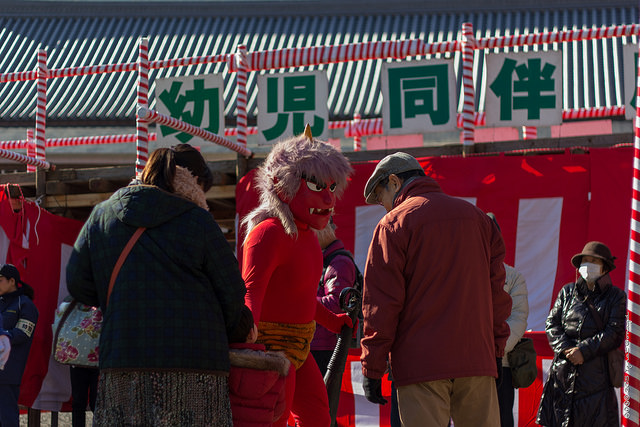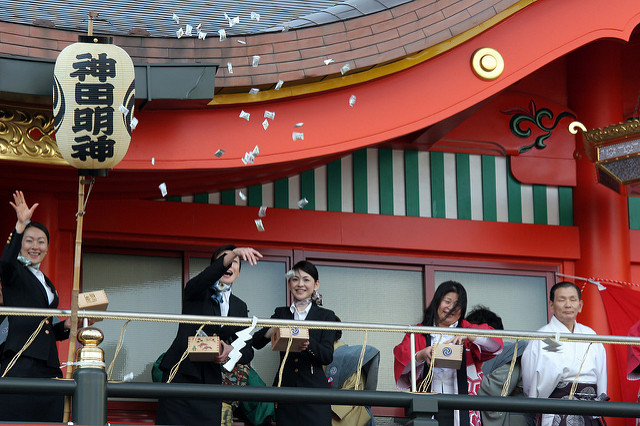Changing of the Seasons
The festival of Setsubun—when people throw soybeans at demons—follows closely on the heels of New Year’s. The word setsubun means “changing of the seasons,” so there are actually four setsubun a year on the day before each new season begins. But because of the importance of the New Year in the Japanese calendar, the setsubun directly before the start of spring was by far the most important and is currently the only one widely celebrated in Japan. When seasons change, people are at their most vulnerable to influenza, colds, or other ailments. The rituals for the festival of Setsubun are meant to purge ones’ house and surroundings of all bad things and to keep disease and misfortune at bay.

(Source: https://bit.ly/2TjnIYm)
Before switching to the Gregorian calendar in the Meiji period (1868-1912), Japan’s annual rituals were closely based on the Chinese calendar. Setsubun falls around the time of the lunar New Year and was originally part of the New Year’s celebrations. In China and Japan, many people believe that misfortunes are caused by demons, or oni. The practice of purging ones’ house of oni was originally a New Year’s Eve ritual in China, and this was adopted in Japan, along with Buddhism in the 8th century. But the question remains, why were soybeans thought to have the power to drive the demons away?

(Source: https://bit.ly/2RQlpiS)
To find an answer, we must go back in time and look at Chinese numerology, where many concepts come in fives to correspond to the five elements—wood, water, fire, metal, and earth. Soybeans were included in what were designated the “5 cereals,” or the five most important crops. Soybeans (or “daizu” [大豆], literally “the big bean”) were considered particularly powerful because they were believed to contain the spirits of all the cereals combined. Mame (豆), or bean, is a homophone for mame (魔滅), which means “destroying evil,” so soybeans were thought to be especially effective weapons against oni demons—somewhat like garlic is believed to be powerful against vampires in the West. This is how throwing soybeans at demons became the central ritual of Setsubun. This ritual is done to purge ones’ life of all the invisible oni demons in ones’ surroundings and to ensure health and good fortune for the coming year.
In schools in Japan, students typically make oni masks at this time. The principal of the school or the teachers might dress up as oni demons, and children will throw roasted soybeans at them, calling “Oni wa soto! (Out with the demons!) Fuku wa uchi! (In with good fortune!).” This ceremony might be repeated at home and is also carried out at various temples throughout Japan. After the bean-throwing ritual (mamemaki), people count out and eat the number of roasted soybeans equal to their age plus one more to protect them in the year ahead. These beans are called fuku-mame (good fortune beans). For good measure, people might also decorate the outside of their houses with prickly holly leaves and sardine heads because oni demons are known to avoid the sharp thorns of the holly and to detest the smell of sardines. In the Kansai region (near Osaka and Kyoto), it’s also typical to eat ehou-maki, an over-sized sushi roll with 7 ingredients (indicating luck). In recent years, eating this traditional dish has become popular throughout Japan.
Setsubun Festival [Tochoji Temple]
If you want to experience Setsubun here in Fukuoka, you can do so! The festival at Tochoji Temple has been continuously held since Muromachi Period, and Seven Deities of Good Fortune and Otafuku (smiling woman) also appear on the day.
During the festival, the multi-armed Kannon statue, Japan’s one of the important intangible cultural assets and Rokkakudo Buddhist sanctum, a cultural asset in Fukuoka City, are open to public and every year the temple is full of worshippers.
On February 3 (Sunday) of Grand Setsubun festival, the bean-throwing ritual will be held lavishly by Toshi-otoko (men who were born in a year with the same Chinese zodiac sign as the current year) and local noted personalities of Fukuoka/ Hakata, as well as rice cakes, oranges, sweets, and more are thrown swiftly from the main hall of the temple. Shops sell Fukumame (fortune beans) and lucky charms, and serve Amazake (sweet fermented rice drink) will be set up.
[The Festival Eve]
13:00 – 18:00, February 2 (Saturday), 2019
- Setsubun bean-throwing: as-needed basis from 13:00
- Fukubiki lottery: 13:00 – 18:00
[Kaiun-Yakuyoke (bringing in fortune and warding off evil) / Setsubun Grand Festival]
10:00 – 18:00, February 3 (Sunday), 2019
- Setsubun bean-throwing: as-needed basis from 09:30
- Goma Prayer (fire ritual) for Kaiun-yakuyoke (warding off evil and bringing in fortune)/ Star Festival/ Fire Festival: from 10:00










